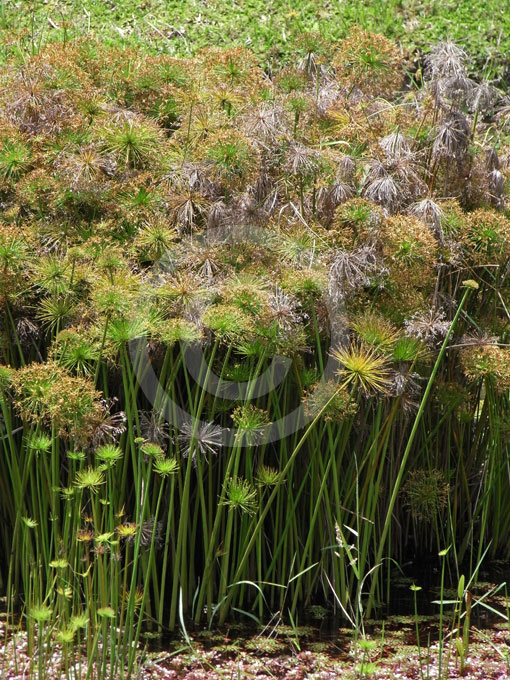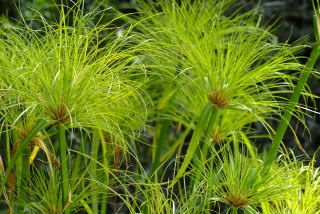

Native to the Southeastern United States, the West Indies, Mexico, Central America, South America, and the Old World.Propagated by division or by rooted plantlets that form when the flower heads touch the water or by cutting off the flower head and floating it upside down in water.It may be grown at the edge of a pond or water garden, in boggy areas, in shallow water and in containers. This architectural grass is highly versatile.While it thrives in consistently moist garden soil, it can also be planted in standing water to 3-5 in. Plant Description Dwarf Papyrus or Cyperus Haspan, is an excellent pond plant that adds a nice accent to your water garden feature.
#CYPERUS DWARF PAPYRUS FULL#
Performs best in full sun or partial shade in wet soils.In ponds, plant in a basket as it may be invasive. While papyrus plants are perennials in warm climates, many gardeners use them as if they were annuals in colder climates. Providing year-round interest, this member of the sedge family is a charming addition to the water garden thanks to its delicate evergreen appearance and fireworks-like flower heads. Atop the stem rests a rounded spiked umbel of yellow-green florets that turn bronze in late summer.
#CYPERUS DWARF PAPYRUS TRIAL#
For evergreen grasses this wounding will really affect their ability to live through the winter.įine Gardening Magazine 2008 Trial Garden Recommendation.Cyperus haspan (Dwarf Papyrus) is a rhizomatous aquatic perennial forming a tuft of upright, three-angled, green stems. Cyperus papyrus Nanus and Baby Tut are dwarf papyrus varieties that make unusual, easy-care house plants on your windowsill. Dividing plants wounds them to some degree.

In areas where winter temperatures remain above 35 degrees it should be considered a perennial and the following information should be useful.Įvergreen or neutral grasses are usually plants that look like grasses but aren't actually classified as grasses, they are generally called grass-like plants.ĭivide evergreen or neutral grasses and grass-like plants in spring only.Įvergreen grasses don't ever go dormant. It should not be expected to live through the winter and begin growing again in the spring. Once the grass turns brown it can either be removed immediately or removed in the spring. Where temperatures get colder than 35 degrees F, the plants should be treated as annuals. Totally versatile as it can go in sun or shade, containers, and landscape plantings including water gardens Egyptian Papyrus adds graceful, dramatic height to any water feature, landscape or large container. King Tut is an evergreen or neutral grass. Cyperus papyrus 'Little Prince' is a vigorous, grass-like foliage plant with huge umbels looking vaguely like giant onion flowers. It is best to keep the soil moist, but once established King Tut has proven to be surprisingly tolerant of dry conditions. King Tut will also do well when planted in normal garden beds. Best flowering and growth results appear in. Must grow with roots in constantly moist or wet soil. Will grow in a container outdoors in summer, and indoors in winter. In warm climates, does well in water garden or moist area. If the plant is put into a pot I would suggest plugging the hole or holes in the bottom of the pot to keep as much water as possible in the pot. Cyperus isocladus ( Dwarf Papyrus ) Slim leaves and flower spikes create an umbrella-like apperance above green stems. The root ball can be submerged but it isn't necessary. The purpose is to keep the bulk of the soil or root mass wet. The crown of the plant should never be covered in water and in fact both of these varieties can thrive in water as shallow as a few inches. Looks beautiful on its own or as the thriller in an arrangement of moisture loving pants.

With shorter stems than King Tut, Prince Tut is quite sturdy and less likely to have stems flop. Fun and interesting, without being so overwhelmingly huge. This dwarf papyrus grows 18' to 24' tall and is ideal for patio water gardens and small ponds. 'Little Tut' is a dwarf papyrus perfectly suited for containers with smooth, triangular stalks topped with rounded umbels of grassy green foliage. A nicely compact form of Egyptian Papyrus, about half the height of King Tut, but with the same large poms on the ends of the stems. It is viviparous and will grow new plants from the tops. The plant can be planted in pots, along the waters edge of a pond, or even in a pond. Dwarf Papyrus (Cyperus haspan) Dwarf Papyrus has thin, dark green stalks topped with light green tufts of foliage. It is a very fast grower and will quickly grow to impressive size when replanted in the spring. Cyperus Papyrus is not hardy enough to survive winters with freezing temperatures and it is not a candidate to overwinter inside.


 0 kommentar(er)
0 kommentar(er)
